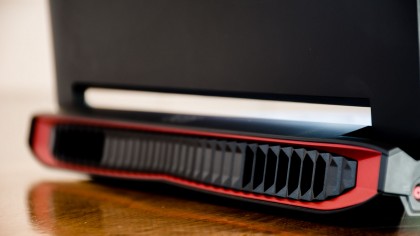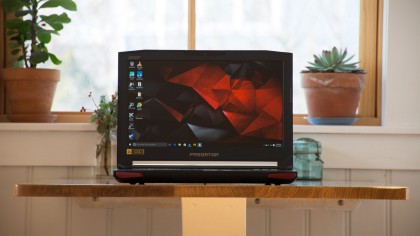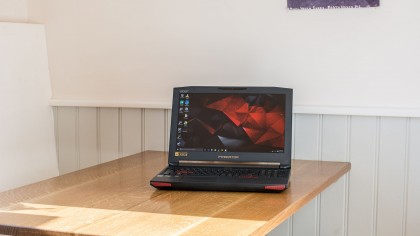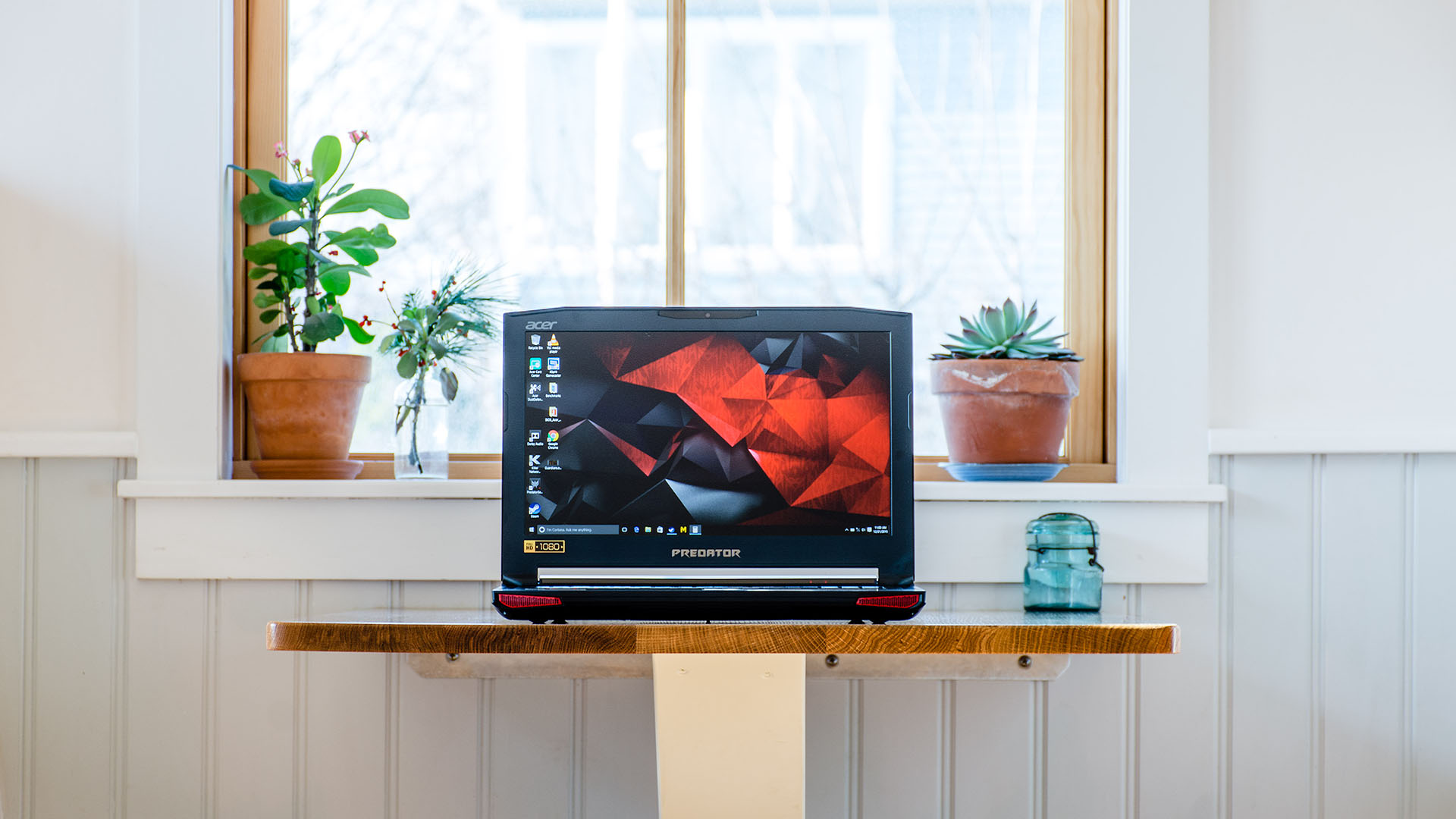Why you can trust TechRadar
With a whopping 32GB of RAM and programs loading from the SSD, along with its Core i7 CPU, I never encountered a situation through regular use where the Predator really struggled. In fact, it breezed along as if nothing was wrong. I tend to leave a dozen or more processor-heavy, Ajax-enabled sites like Gmail, Facebook, and Twitter open at any given time, and even with a few videos on pause, I was able to jump in and out of games without issue.
The SSD makes a big difference in games with lots of loading. I never experienced any of Just Cause 3's dreaded, ultra-long loading time issues. The GeForce 980M had no problem running the game at decent settings, and I couldn't help myself but to plug it into my television and play on the big screen for a while. Again, even in a two-screen configuration, I didn't experience any problems with performance.

Benchmarks
Here's how the Acer Predator 15 performed in our suite of benchmark tests:
- 3DMark: Cloud Gate: 22,590; Sky Diver: 21,829; Fire Strike: 8,277
- Cinebench CPU: 673 points; Graphics: 66 fps,
- GeekBench: 3,668 (single-core); 13,255 (multi-core)
- PCMark 8 (Home Test): 3,378 points
- PCMark 8 Battery Life: 3 hours and 17 minutes
- Middle-earth: Shadow of Mordor (1080p, Ultra): 67 fps; (1080p, Low): 140 fps
- Metro: Last Light (1080p, Ultra): 33 fps; (1080p, Low): 114 fps
The performance of the Predator falls short of the EON15-X, as Origin's machine really thrives from having a desktop processor and having a GPU with double the RAM. The Cinebench score speaks to the superiority of the EON15-X, with that laptop scoring 874 points, compared to the Predator's 671. In fact, performance-wise, the Predator is much closer to the GS60 Ghost Pro, narrowly beating it out in all but the PCMark 8 Home Test. Even then, it lost by a negligible 15 points.
Metro: Last Light and Middle-earth: Shadow of Mordor were able to run at a competent frame rate, even on Ultra settings. Mordor on Ultra was able to average 67 fps, while Metro reached just half that number, at 33 fps. With games set to their optimal settings, either through the GeForce software or the games themselves, graphics and framerate will satisfy any gamer's wants.
For modern games, the Predator does well. Just Cause 3, with its huge open world and physics-based, movie-realistic explosions, was a real treat. After reading about performance issues with the game, I was worried it would be a slog on a laptop rather than a dedicated desktop, but I'm happy to report the Predator handled it well. The only time I saw a real chug was when I was playing on battery power, but even that was brief and largely a result of so much happening on-screen.

Display
The Predator has support for G-Sync monitors, but the display on the machine itself isn't G-Sync enabled. While that would certainly add to the already steep price for the tricked-out Predator 15, it would be appreciated to at least have the option.
Sign up for breaking news, reviews, opinion, top tech deals, and more.
That's especially since the display is such a pleasure to behold. I had to check several times during testing where the screen needed to be set to 50% brightness, because even at half its capacity, the screen shines brightly.
High-definition movies look fantastic, at a level of clarity that somehow seems to rise above its quoted 1,920 x 1,080 resolution. Games, too, look wonderful, with vibrant colors that look alive. Even games with relatively dull color palettes, like Middle-earth: Shadow of Mordor, have an an extra dimension of graphical fidelity, thanks to the bright, colorful screen.
As great as the screen looks, an UHD option would have been a nice addition, something to take an already great machine to the next level. However, pushing all those pixels while remaining competitive in performance is a task for any GPU, so it's understandable why Acer chose to skip the option. Adding a second GPU could have been another possibility, but it too would have inflated the already high price and weight.

Battery
Where the Predator shines compared to its competitors is in its battery life. A PCMark 8 Battery Life score of 3 hours and 17 minutes puts it an hour above both the EON15-X and the GS60.
Watching Guardians of the Galaxy on a loop at 50% screen brightness, listening through a pair of headphones, the GS60 made it to 2 hours 28 minutes, just barely enough to finish the movie. The Predator, on the other hand, running the same conditions, lasted an impressive 4 hours 22 minutes.
The EON15-X lasted just over 2 hours through practical use, while the Predator made it 3 hours and 5 minutes of me jumping back and forth between Just Cause 3, Call of Duty: Black Ops 3 and regular internet surfing. I left all my tabs running while I gamed, and the screen was at 50% brightness, but I also left the fans running as they normally would.
All that battery life makes the Predator a stand-out among its peers. Merely watching movies on it, you could almost make it from one coast to the other on an airplane before it needed to be plugged in.
And that movie experience would be without a big trade-off. The screen at 50% is still a comfortable brightness, and I'd be willing to wager with some more tweaks, the battery life could be stretched even further.

Cooler runnings
The cooling on the Predator is exceptional. Playing Just Cause 3 for extended sessions with the graphics optimized via GeForce Experience had the fans spinning constantly. The Predator is able to move so much air with the help of the FrostCore cooler that my legs were actually starting to feel cold from the breeze.
The vents on the bottom and back of the laptop are large and facilitate the air flow. Under normal use, simply browsing the internet, I was able to shut the fans down entirely, and never once did I find the laptop uncomfortably warm.
Another feature of the Predator's cooling system – and it really cannot be overstated how well the cooling works – is the Acer Dust Defender feature. It can be manually activated, but under normal use, every three hours the Predator will spin its fans in reverse to help get rid of accumulated dust trapped inside.
Unfortunately, all that cooling comes at the expense of constant fan noise. When they're spinning, they're loud. It's nice that the Predator has a built-in macro for turning the fans off, but who wants to shut off their fans while running a graphics-intensive game?
The fan noise is an extra bummer when juxtaposed against just how excellent the speakers sound. The two front facing speakers produce a rich, clear sound with no distortion. And the subwoofer on the bottom adds some boom to the bounce, making this the best-sounding laptop I've tested.
On top of sounding fantastic, this laptop also gets loud. At no point did I ever want to play a game at 100% volume. Seriously, it's loud.
